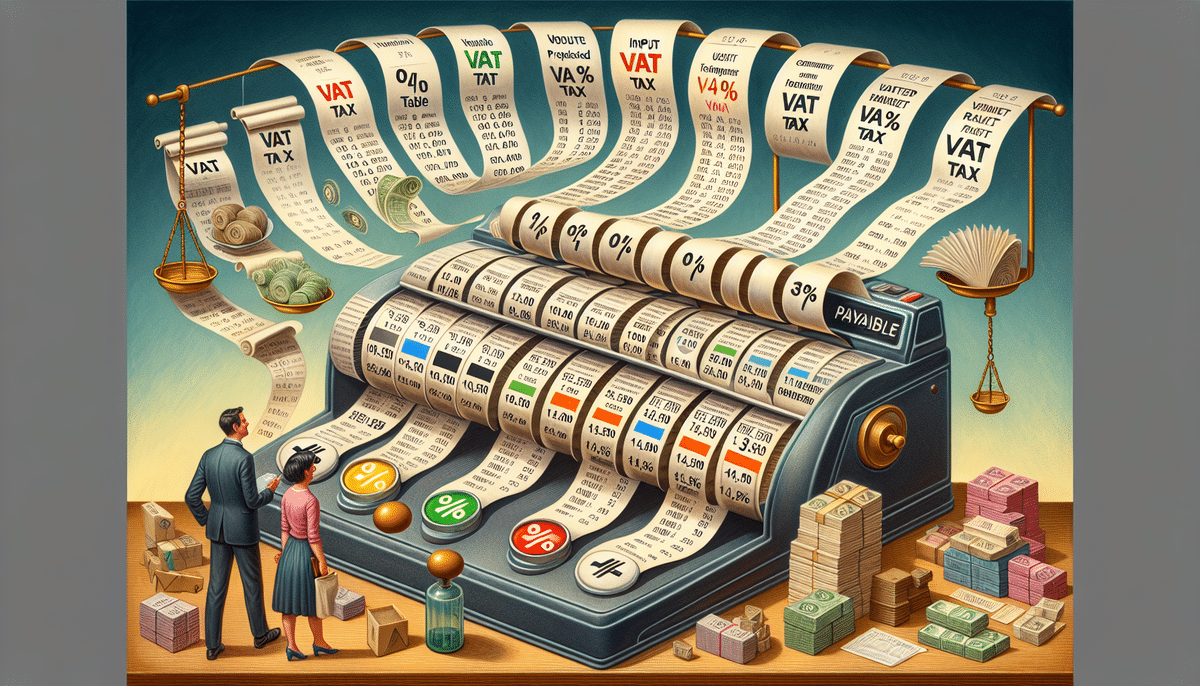Understanding the Basics of Value-Added Tax (VAT)
Value-Added Tax (VAT) is a consumption tax levied on the price of goods and services at each stage of production and distribution. As an indirect tax, VAT is collected by businesses on behalf of the government and ultimately paid by the end consumer. Widely implemented globally, VAT rates and regulations vary across different countries. This article provides a comprehensive overview of VAT, including its history, functionality, comparisons with sales tax, and future trends.
What is VAT and How Does it Work?
VAT is imposed on the value added to products and services at every production and distribution stage, from raw materials to the final consumer product. Businesses registered for VAT are required to charge VAT, known as output tax, to their customers while they can reclaim the VAT they have paid on their own purchases, referred to as input tax. The difference between output tax and input tax is remitted to the government.
Not all goods and services are subject to VAT. Essential items like basic foodstuffs and certain medical supplies are often exempt. Moreover, specific industries, such as hospitality, may benefit from reduced VAT rates or reliefs. Accurate record-keeping and compliance with VAT regulations are crucial, as non-compliance can lead to significant penalties and legal issues. According to the ShipScience VAT Compliance Guide, effective VAT management can enhance business credibility and operational efficiency.
A Brief History of VAT
VAT was first introduced in France in the 1950s to replace a complex system of indirect taxes. Its success led to adoption by numerous European countries and eventually became a standard taxation method globally. Interestingly, Ghana was the first African country to implement VAT in 1985, setting a precedent for other nations on the continent.
Over the decades, VAT systems have undergone various modifications to accommodate economic changes. Different countries implement varying VAT rates based on the nature of goods and services, with exemptions often granted for essential items. For example, the European Union allows member states to set reduced VAT rates for necessities like food and medicine. The revenue generated from VAT plays a pivotal role in funding public services, including healthcare, education, and infrastructure. The European Commission's VAT documentation provides detailed insights into these implementations.
VAT vs. Sales Tax: What's the Difference?
While both VAT and sales tax aim to collect consumption taxes on goods and services, they differ fundamentally in their application. Sales tax is imposed only at the final point of sale to the consumer, calculated as a percentage of the sale price. In contrast, VAT is levied at each production and distribution stage based on the value added, making it a more comprehensive and transparent taxation method.
For instance, in the United States, sales tax is commonly used, whereas most European countries rely on VAT. The iterative nature of VAT can lead to higher overall tax collection compared to sales tax. Additionally, VAT systems often incorporate exemptions and reduced rates for essential goods, enhancing their fairness. However, the complexity of VAT calculations requires robust administrative frameworks, as detailed by the ShipScience VAT vs. Sales Tax Comparison.
Who Pays VAT and When is it Applicable?
VAT applies to businesses engaged in the production or trade of VAT-subject goods and services. Businesses must register for VAT once their annual turnover exceeds a specific threshold, which varies by country. Voluntary registration is also possible for businesses below the threshold, allowing them to reclaim input tax.
End consumers bear the final VAT cost when purchasing goods and services. Additionally, VAT applies to imports, where customs authorities collect the tax at the point of entry. Depending on national tax laws, certain imports may be exempt or subject to reduced VAT rates. The ShipScience Guide on VAT and Imports provides further clarification on these regulations.
The Advantages and Disadvantages of VAT
One of the primary advantages of VAT is its efficiency in tax collection, reducing opportunities for tax evasion and ensuring a stable revenue stream for governments. According to the International Monetary Fund, VAT is less susceptible to evasion compared to other taxes due to its multi-stage collection process.
VAT also promotes transparency and encourages businesses to maintain accurate financial records, fostering better financial management and decision-making. However, VAT can be regressive, disproportionately affecting low-income consumers since they spend a larger portion of their income on VAT-inclusive goods and services. To mitigate this, many countries offer exemptions or reduced rates for essential items.
Moreover, the complexity of VAT systems can impose higher administrative costs on businesses, particularly small enterprises that may lack the resources to manage extensive compliance requirements. The ShipScience VAT Administration Overview discusses strategies to streamline VAT compliance for businesses of all sizes.
Common Misconceptions About VAT
There are several misconceptions surrounding VAT that can lead to confusion among businesses and consumers alike. A prevalent myth is that VAT is a tax on business profits, which is inaccurate. VAT is solely based on the value added to goods and services, independent of a company's profitability.
Another misunderstanding is that VAT only applies to large businesses. In reality, any business exceeding the designated turnover threshold must register for VAT, and smaller businesses opting for voluntary registration are also subject to VAT obligations. It's crucial to understand that VAT is a pass-through tax; businesses collect it from customers and remit it to the government, without it affecting their profit margins directly.
Failure to register for VAT when required or incorrectly calculating VAT can result in severe penalties. The ShipScience VAT Misconceptions Article provides detailed explanations to help businesses navigate these misunderstandings.
Understanding the VAT Registration Process
Registering for VAT involves several steps to ensure businesses comply with tax regulations. Initially, businesses must assess whether their annual turnover exceeds the VAT registration threshold set by their country. Once determined, the following steps are typically required:
- Application: Submit an application for VAT registration to the relevant tax authority, providing essential business information such as turnover, bank details, and trading history.
- VAT Number: Upon approval, businesses receive a unique VAT identification number, which must be displayed on invoices and official documents.
- Charging VAT: Begin charging VAT on eligible goods and services, ensuring accurate calculation and documentation of both output and input tax.
- Record-Keeping: Maintain meticulous records of all transactions to facilitate VAT reporting and compliance audits.
Proper registration is crucial for legal compliance and to leverage the ability to reclaim input tax. The ShipScience VAT Registration Guide offers a step-by-step walkthrough of the process.
How to Calculate VAT for Your Business
Calculating VAT accurately is essential for compliance and financial management. The fundamental formula for VAT calculation is:
VAT Payable = Output Tax – Input Tax
Output Tax: VAT collected from customers on sales.
Input Tax: VAT paid on purchases and expenses related to the business.
For example, if a business collects $5,000 in output tax and has $3,000 in input tax, the VAT payable to the government is $2,000.
Businesses can utilize various online tools and accounting software to streamline VAT calculations. However, consulting with tax professionals is advisable to ensure accuracy and adherence to the latest tax laws. The ShipScience VAT Calculation Tools section provides resources to aid businesses in this process.
Claiming Back Input Tax: Everything You Need to Know
Businesses can reclaim the VAT paid on their purchases and business expenses, known as input tax, by offsetting it against their output tax liabilities. To successfully claim back input tax, the following conditions must be met:
- Business Purpose: The expenses must be directly related to the business’s taxable activities.
- Proper Documentation: Valid VAT invoices and receipts must be maintained as evidence of input tax payments.
- Timely Claims: Input tax claims should be submitted within the stipulated deadlines, typically aligned with VAT return periods.
It's important to note that VAT paid on non-business-related expenses, such as personal purchases, is not reclaimable. Incorrect claims can lead to audits, penalties, or interest charges. The ShipScience Input Tax Claim Guidelines provide comprehensive instructions to ensure accurate and legitimate claims.
Common Types of VAT Rates and How They Apply
VAT systems commonly feature multiple rate categories to accommodate different types of goods and services. The primary VAT rates include:
- Standard Rate: Applies to most goods and services. For example, the EU's standard VAT rate ranges from 17% to 27%, depending on the country.
- Reduced Rate: Applies to essential goods and services such as food, books, and pharmaceuticals. These rates are typically lower than the standard rate to make essentials more affordable.
- Zero Rate: Applied to exports and certain specific goods and services. While the VAT rate is 0%, businesses can still reclaim input tax on these transactions.
- Exempt: Certain goods and services may be entirely exempt from VAT, meaning no VAT is charged, and input tax cannot be reclaimed.
Understanding the applicable VAT rates is crucial for accurate pricing and compliance. The ShipScience VAT Rates Overview offers detailed information on how different rates apply across various sectors.
The Impact of Brexit on VAT in the UK
The United Kingdom's exit from the European Union has significantly altered VAT regulations for UK businesses engaged in trade with EU member states. Key changes include:
- VAT on Imports and Exports: New VAT rules require businesses to handle VAT on imports and exports differently, often necessitating registration for VAT in EU countries if certain thresholds are exceeded.
- E-Commerce VAT Regulations: The introduction of the EU VAT e-commerce package means online businesses must comply with new VAT collection and reporting requirements for sales within the EU.
- Changes in VAT Rates: Some VAT rates may have shifted due to new trade agreements and regulatory changes post-Brexit.
UK businesses must stay informed about ongoing changes to ensure compliance and mitigate potential disruptions. The ShipScience Brexit VAT Impact Analysis provides an in-depth examination of these regulatory changes.
Managing Your VAT Returns and Payments
Effective management of VAT returns and payments is essential for compliance and avoiding penalties. Businesses must adhere to the following practices:
- Regular Filing: VAT returns must be filed regularly, typically monthly, quarterly, or annually, depending on the business's turnover and national regulations.
- Accurate Reporting: Ensure all VAT collected and paid is accurately reported in the VAT return to reflect true financial positions.
- Timely Payments: VAT payments should be made promptly following the submission of VAT returns to avoid interest charges and penalties.
- Record Maintenance: Maintain comprehensive records of all transactions, including sales, purchases, and VAT payments, for at least the legally required period.
Automated accounting systems can assist in managing VAT returns and payments efficiently. Additionally, consulting with tax professionals can help ensure accuracy and compliance. The ShipScience VAT Returns Management resource offers strategies for effective VAT administration.
Tips for Avoiding Common VAT Mistakes
Businesses often encounter challenges when dealing with VAT, leading to common mistakes that can be costly. Here are some tips to avoid these pitfalls:
- Understand Applicable VAT Rates: Ensure clarity on which VAT rates apply to different products and services to avoid incorrect charging.
- Accurate Record-Keeping: Maintain detailed and organized records of all transactions to facilitate accurate VAT reporting and input tax claims.
- Timely Filing and Payments: Adhere to deadlines for VAT returns and payments to avoid penalties and interest charges.
- Regular Training: Stay updated with the latest VAT regulations and provide training for staff involved in financial processes.
- Use Reliable Accounting Software: Implement accounting systems that can handle VAT calculations and reporting accurately.
By proactively addressing these areas, businesses can minimize errors and ensure smooth VAT compliance. The ShipScience Common VAT Mistakes article delves deeper into typical errors and how to prevent them.
The Future of VAT: Trends and Predictions
The landscape of VAT is continually evolving, influenced by technological advancements and shifts in global trade practices. Key trends and predictions for the future of VAT include:
- Digitalization of VAT Compliance: Increased use of digital tools and automation in VAT reporting and compliance processes to enhance accuracy and efficiency.
- Expansion of VAT Rules: As international trade grows, VAT regulations may expand across borders to address cross-border transactions more effectively.
- Real-Time Reporting: Implementation of real-time VAT reporting systems to provide instant data on transactions, reducing fraud and improving transparency.
- Alternative Taxation Models: Exploration of alternative taxation methods that may complement or, in some cases, replace traditional VAT systems.
Businesses must stay abreast of these developments to adapt their financial strategies and maintain compliance. The ShipScience Future of VAT Report offers insights into upcoming changes and how businesses can prepare.




















